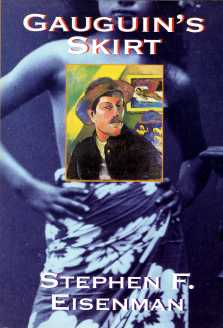|
Gauguin's skirt / Stephen T.
Eisenman. - New-York, London : Thames and Hudson, 1997. -
232 p. : ill. ; 24 cm.
ISBN 0-500-01766-2
|
Stephen F. Eisenman est
professeur d'histoire de l'art à Los Angeles ; pour
tenter d'éclairer la vie et l'œuvre de Gauguin en
Polynésie, il ne s'en tient pas à sa seule
discipline, et fait appel aux ressources croisées de
l'anthropologie et de l'ethnologie. On entrevoit
d'intéressantes perspectives de renouvellement ; mais,
très vite, l'esprit de système compromet les
résultats espérés.
Quand il débarque
à Tahiti pour la première fois en juin
1891, Gauguin est surpris par l'accueil moqueur des
autochtones. On lui fait alors comprendre que son apparence
extérieure et sa mise, le désignent comme notoirement
différent des autres popaa ; en
particulier, portant les cheveux longs, il pourrait passer pour
efféminé — aux yeux des
Polynésiens un mahu.
De cette anecdote, connue par
le récit d'un témoin français 1,
Eisenman s'empare pour étayer une
théorie : « From the
moment he stepped off the boat […] Paul Gauguin's colonial
prestige was under assault and his sexuality was in
question ». Au prix d'approximations
souvent hasardeuses, Eisenman s'appuie sur cet incident pour
développer une analyse dont, par ailleurs, certains aspects
ne manquent ni d'originalité, ni de pertinence.
Marginalisé par les
colons, Gauguin pouvait entretenir avec la
société polynésienne des relations
d'échange tendant vers l'équilibre. Mais pour
être accueilli sans restriction, il lui fallait un statut
social acceptable ; Eisenman suggère alors son
astucieuse hypothèse, négligeant le fait que les
Polynésiens étaient aptes à
reconnaître (et apprécier) les talents du
peintre/sculpteur : il était celui qui
fait des hommes 2 : point besoin de recourir
à un artifice laborieusement
échaffaudé.
La fixation d'Eisenman sur la « gender
liminality »
supposée de Gauguin, ne doit pourtant pas masquer certaines
qualités remarquables. Il est un des premiers
à avoir pris le temps d'écouter les
Polynésiens parler de Gauguin et comble ainsi une lacune
aussi
regrettable que peu compréhensible … d'autant
plus que,
ce faisant, il ouvre la possibilité de
renouveler radicalement l'analyse de certaines
œuvres du peintre, non des moindres, et non
des moins énigmatiques.
| 1. | Lieutenant Jénot,
« Le premier séjour de Gauguin
à Tahiti », Gazette des Beaux-Arts, Paris,
janvier-avril 1956. | | 2. | Cf. Noa
Noa
et, plus tard, aux Marquises, l'accueil que lui réserve
Haapuani, dépositaire des savoirs traditionnels et,
lui-même, expert dans l'art de travailler le bois. |
|
|
NOTE
DE L'ÉDITEUR : Gauguin's
Skirt is about contemporary Tahitians and a long-dead French
painter, sex today and sex in the late nineteenth century, and
colonialism new and old. Written on the boundary between art history
and anthropology, it enters the domains of biography and mystery.
Gauguin went to Tahiti in 1891
in search of an exotic paradise. What he found instead was a French
colony ostentatiously divided by race, sex, and class. At once, the
artist began to explore the complexities of his world through the media
of drawing, painting, printmaking and sculpting. These works depict
ancient and modern Tahitians at labor and leisure, and the fecund
landscape of Polynesia ; they also expose the contradictory
perspective of an avant-garde artist exiled both from the modern French
metropolis and from the secrets of the indigenous Maohi culture.
Based upon extensive archival
and ethnographic research in France and Tahiti, Gauguin's
skirt challenges interpretations of the political and gender
content of the notorious artist's pictures. It compares European and
Polynesian sexualities and spiritualities, and argues that many of
Gauguin's most famous pictures are far more knowing than had previously
been supposed.
|
| COMPLÉMENT
BIBLIOGRAPHIQUE |
- « Gauguin's skirt », London : Thames and Hudson, 1999
|
- « Paul
Gauguin : artist of myth and dream » ed. by
Stephen F.
Eisenman, Milan : Skira, 2007 ;
« Paul
Gauguin : artista di mito e sogno » a cura
di Stephen
F. Eisenman, Milano : Skira, 2007
|
|
|
| mise-à-jour : 14
mars 2016 |

|
|
|
|